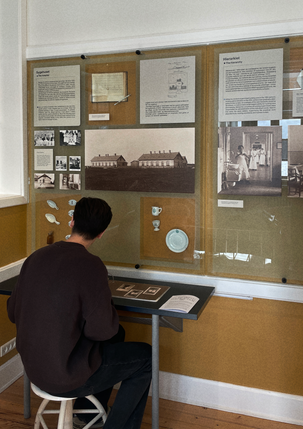
Immersive Experiences in Traditional Museums
This project is the outcome of my Master's thesis, and it explores how museums must become more participative, dynamic, and audience-centered to stay relevant in a rapidly changing society. 5-months of research, talking with museum experts, prototyping, testing, interviewing, and a collaboration with the Danish Museum of Nursing History (DMNH), we ended up with five design strategies to enhance traditional museums through immersive experiences: storytelling, interactivity, learning, social interaction, and environment.


Traditional museums, often designed for passive observation, risk becoming outdated in an era where audience engagement is crucial. To remain relevant, museums must evolve into dynamic, immersive spaces that foster interaction, learning, and emotional connection. However, many museums lack clear strategies to achieve this transformation.


SOLUTION
We immersed ourselves in the world of museum design, engaging with industry professionals, visiting numerous museums to experience their spaces firsthand, and conducting in-depth research on immersive experiences. Our approach was research through design, with a specific focus on the Danish Museum of Nursing History. To bring our insights to life, we created an interactive, immersive replica of one of their rooms. This allowed us to compare, test, and analyze the differences between the original and our reimagined version, leading to valuable conclusions.
FINDINGS
Our research confirms that incorporating storytelling fosters emotional engagement, while interactivity enhances learning and visitor absorption. Social interaction enriches the museum experience, and a thoughtfully designed environment strengthens engagement and sensory immersion. These strategies, when applied intentionally, provide actionable insights for designing more immersive and audience-centered museum experiences.
TIME
5 months
METHODS
Research Through Design, Design Lab, Qualitative Research (Interviews), Prototyping, User Testing
TOOLS
Adobe Suite, Miro, Google Workspace, Procreate, Projectors, Cardboard, Paper and Scissors. And Tape.
SKILLS
Experience Design, Visitor Experience Design, Museum Design, Design Research, Interaction Design, Prototyping, Qualitative Research


RESEARCH & DEFINE
Our research phase lasted nearly two months, during which we delved into existing studies and literature on museum design, interviewed experts from museums in Vejle and Kolding, and conducted extensive self-observations in as many museums as possible. We also familiarized ourselves with the Danish Museum of Nursing History, and the problems they currently face.
The Nursing History museum, established in the late 1980s, has maintained its original exhibition layout with consistent thematic elements and artifacts, occasionally featuring different pop-up exhibits. However, the museum now confronts challenges in attracting visitors and effectively conveying its message. We started to wonder: How can we as designers help the Danish Museum of Nursing History create immersive experiences to revitalize visitor engagement and effectively communicate their message?


IDEATE AND DESIGN
The ideation and design phase involved brainstorming, prototyping, brainstorming, and sketching to explore and refine ideas. We then moved on to low-fidelity prototypes and did internal testing as part of our process.
We translated our research findings into a tangible exhibition prototype based on an exhibition room at the Danish Museum of Nursing History. The idea was never to end up with a high-fidelity prototype or finalized exhibit. Instead, we wanted to take our findings and show the DMNH how they could transform their already existing exhibits into more immersive experiences that support their goals.
By this stage, we had already developed strategies for enhancing visitor experiences in traditional museums. However, we aimed to validate their effectiveness by putting them to the test ourselves.

USER TEST AND FINDINGS
We gathered a group of participants and first took them to the Danish Museum of Nursing History, interviewing them afterward to capture their initial impressions. A few months later, we invited the same group to revisit the museum, this time experiencing our interactive, immersive version.
The goal of the study was to either validate or challenge our findings from previous research, including literature reviews, observations, and expert interviews.
Our study identified five key strategies that traditional museums can use to create more immersive exhibitions:
-
Storytelling – Personal stories enhance emotional engagement, empathy, and memorability, especially in a multisensory setting. The Nursing Museum has a rich resource of donated stories and items, which should be incorporated more into exhibitions.
-
Interactivity – Interactive exhibits improve engagement, learning, and enjoyment, making experiences more immersive. They should be simple, intuitive, and strategically placed to balance predictability with surprise.
-
Learning – Catering to different learning styles (touch, smell, sound, video, text) makes exhibits more inclusive and engaging. Over-reliance on one sense can lead to disengagement, while multisensory displays enhance enjoyment and retention.
-
Social Interaction – Museums are inherently social spaces, and interactive exhibits encourage engagement and discussion. Exhibitions should allow group participation and include spaces for conversation and reflection.
-
Environment – Elements like lighting, sound, and objects shape storytelling, engagement, and emotions. Thoughtful environmental design in the Nursing Museum can foster respect, empathy, and a deeper connection to the exhibits.






